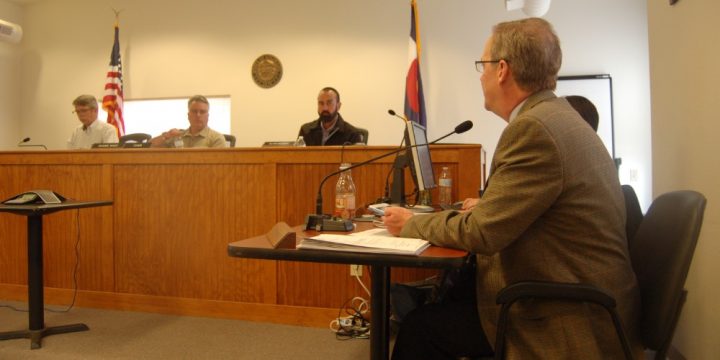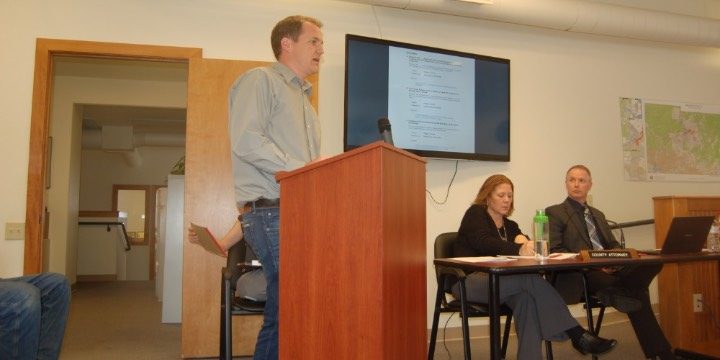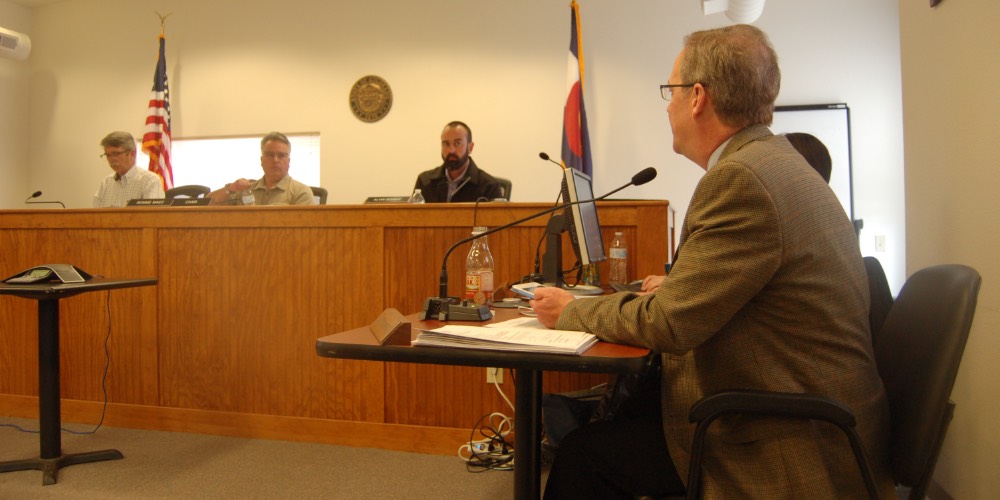We learned a number of things during the Archuleta Board of County Commissioners’ meeting, yesterday on Tuesday, February 5, when the BOCC considered Resolution 2019-09:
A RESOLUTION OF THE BOARD OF COUNTY COMMISSIONERS OF ARCHULETA COUNTY, COLORADO APPROVING THE PRINCIPLES AND PARAMETERS FOR CONSTRUCTION OF THE FRED C. HARMAN III LAW ENFORCEMENT COMPLEX
About a few things, we were left confused.
One thing we learned: the Archuleta County Republican Party leadership, in the form of our three Republican County Commissioners, our Republican Sheriff, and the leadership of the Archuleta County Republican Party — chair Marilyn Harris, vice chair Deborah Van Gundy, and president of the Archuleta County Republican Women Carol Mellberg — made it clear that they’re all willing to dismiss fiscally conservative approaches to government, so long as we’re talking about expensive temporary housing for alleged criminals. When the subject is a County jail, our Republican leadership is happy to pull money out of road maintenance and other public services to build a Taj Mahal jail in the Harman Park subdivision.

Also weighing in, in favor of a debt-funded $13 million jail as part of a future “Law Enforcement Complex,” was our new Undersheriff, Derek Woodman; a former Republican Party County Commissioner candidate, Veronica Medina; former Commissioner Clifford Lucero; and local developer Jack Searle. We also heard encouragements from one of the architects hired to design the (oversized?) jail: Brad Ash.
We heard protests about the debt-funded scheme from a few citizens. Local activist Mark Weiler. Former County Sheriff candidate Rob Keating. Citizen Joanne Zuccarello. Citizen Darrell Brueckner. The editor of the Daily Post (Me.) The protests were in vain.
It was fascinating, to me, to hear the jail proponents argue — repeatedly, and passionately — that the community really, really needs a jail. “We’re legally required to have a jail. Our deputies are at risk driving inmates to Durango. It’s inconvenient for everyone, including the inmates’ families, when we house inmates in Durango.” We heard this argument repeated ad nauseam at yesterday’s meeting.
In fact, I don’t believe there was a single person in the room, yesterday, who believes the community doesn’t need a jail. Certainly, no one who stood up to the microphone to protest the $13 million debt was arguing that the community doesn’t need a jail. Rather, the opponents were arguing that we don’t need a Taj Mahal.

Later, we learned that architects Brad Ash and Bob Johnson and their team will be paid $953,000 to design the jail, even though they already been paid generously, over the past three years, as they showed the BOCC repeated versions of the same jail — on Hot Springs Boulevard, on Main Street adjacent to the current (abandoned) jail, in Aspen Village near the Parelli Building, and on the current site in Harman Park.
We learned that the BOCC had no interest in bidding out the jail design in a competitive process.
The three Republican Commissioners were quite pleased with the current team of architects.

When I asked the BOCC at yesterday’s meeting if architect Brad Ash could explain why it will cost the taxpayers a million dollars for a set of construction drawings — for a jail that, essentially, was already designed three years ago, and that’s essentially the same jail design used by Reilly Johnson Architects in other Colorado communities — BOCC chair Ronnie Maez asked Mr. Ash if he’d like to address that issue.
“I don’t think I need to,” said Mr. Ash. “Unless you guys have direct questions regarding his comment.”
The BOCC did not have any direct questions. So that was the end of that particular discussion.
I’ve been writing about COP (Certificates of Participation) schemes for more years than I care to count. Although the Colorado Constitution clearly states that any multi-year government financial obligation must be approved by the voters, Colorado governments have been using COPs to create virtual multi-year financial obligations since the 1970s.
There are two main reasons why I write critically — year after year — about COP funding schemes. First of all, they violate the spirit of the Colorado Constitution, essentially violating the taxpayers’ constitutional right to determine the level of debt we are willing to assume.
The Archuleta BOCC believes it’s proper to force a $13 million debt down our throats, when the three of them want a new Taj Mahal jail. (Did the fact, that two of the three Commissioners are former law enforcement officers, play into this decision? We will never know.)
In February 2012, the Colorado Division of Criminal Justice published their Correctional Population Forecasts for the Director of the Legislative Council and the General Assembly, to fulfill their legal mandate pursuant to CRS 24-33.5-503. Per that state law, DCJ has prepared projections of these jail populations since the mid-1980s. From the report summary, from seven years ago:
The Colorado prison population is expected to decline by 15.8 percent between the end of FY 2011 and June 2018, from an actual population of 22,610 to a projected population of 19,041 inmates. The number of men in prison is expected to decrease 15.6 percent during this time frame, from 20,512 to 17,309, while the number of women in prison is expected to decrease 17.4 percent, from 2,098 to 1,732…
Something rather strange took place during the Great Recession, between 2008 and 2013. Colorado saw a significant drop in our crime rate, and a correlated drop in the number of citizens locked up in jails and prisons. (This decline in the number of inmates was also evident locally, as reported by the Archuleta County Sheriff’s Office.)
Here’s a chart from the 2012 DCJ report. The blue line shows actual and projected “new prisoners.” The green and brown lines refer to parole violations and “returns.”
Seemed like our state, taken as a whole, was headed in a positive direction in terms of crime. That was seven years ago. I’ve not yet come across any clear explanations for the decline in criminal activity here in Colorado during the Great Recession, although the legalization of marijuana may have played a role in the number of persons arrested for drug violations. But the decline reflected one very simple fact: more prisoners were released from jail than were added.
In January 2018, the DCJ published another annual report. Here’s a much more depressing quote from the summary:
The Colorado prison population is expected to increase by 38.2% between fiscal years 2017 and 2024, from an actual year-end inmate population of 20,101 to a projected population of 27,770. This rate of growth is substantially higher than that predicted at this time last year.
During FY 2018, the overall inmate population is projected to decrease slightly, by 1.6%. However, strong growth is expected over the subsequent six years, averaging 5.8% per year. The number of men in prison is expected to increase from 18,108 to 24,806 (37.0%) by the end of FY 2024, while the number of women in prison is expected to increase from 1,993 to 2,964 (48.7%) across the same time frame.
Impressive growth. Almost 6% per year. Especially, we will be locking up more women.
Here’s a chart from that same 2018 report:
An 38% increase in Colorado’s prison population by 2024? I assume our Daily Post readers will find this prediction disturbing. But it appears DCJ has every reason to make such a depressing estimate. Over the past 5 years, criminal filings — that is, people accused of crimes by law enforcement and district attorneys — have increased by about 46%, according to DCJ.
46%. I cannot for the life of me think of anything else in America that has increased by 46% over the past 5 years, except of course the price of housing, which has increased by around 100% here in Archuleta County, over than same time period.
Viewed cynically, you might be tempted to suggest that taxpayer investments in bigger jails and prisons will serve as Colorado’s answer to its housing crisis. Not a very cost-effective solution, perhaps… but who ever claimed government was cost effective?



